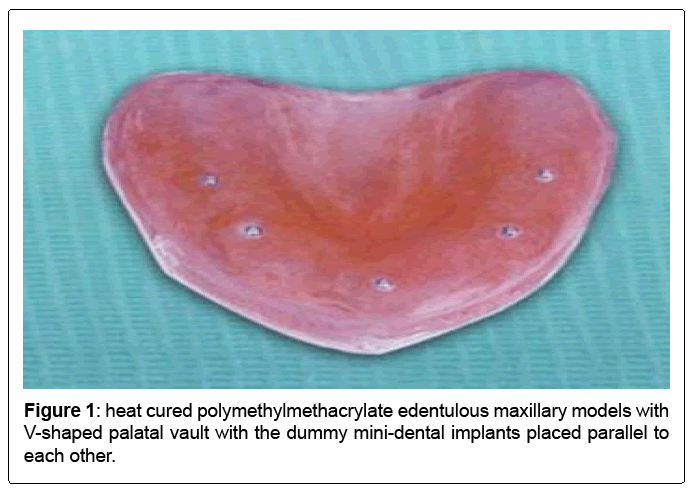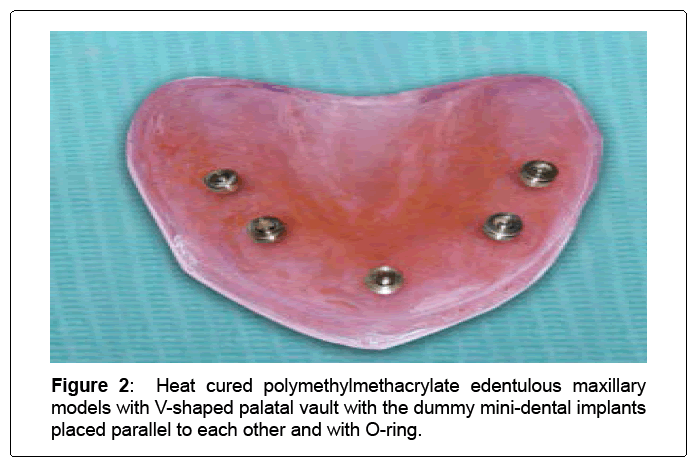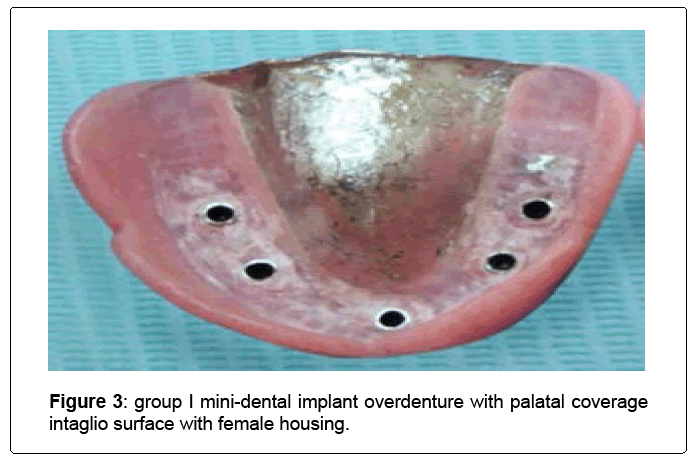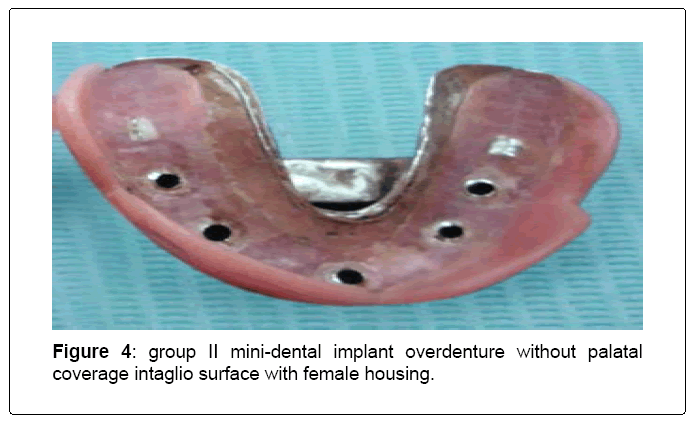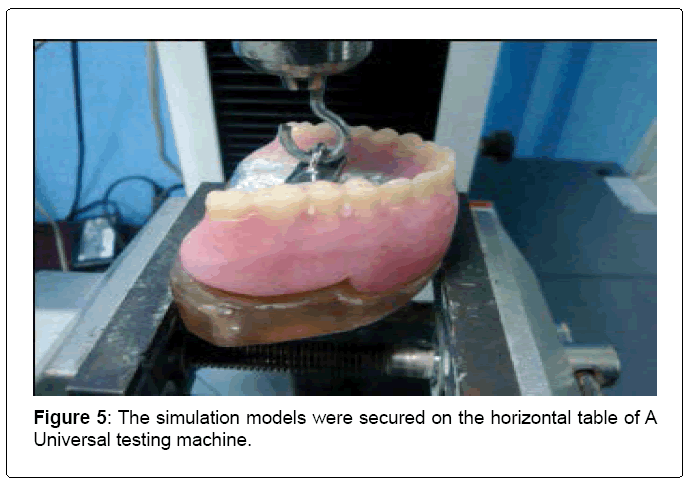Research Article Open Access
The Influence of Palatal Coverage on the Retention Force and Fatigue Resistance of Mini Dental Implant Maxillary Overdenture
Nesreen El Mekawy*, Ahmed Khalifa Khalifa and Ekhlas AbdualgabbarFaculty of Dentistry, Mansoura University, Egypt
- *Corresponding Author:
- Nesreen El Mekawy BDS, MSc, Phd
Associate professor of Removable Prosthodontics
Faculty of Dentistry, Mansoura University
Mansoura, Egypt
Tel: 0201227884473
Fax: 0020502260173
E-mail: nesreen_ elmekawy@yahoo.com
Received Date: February 19, 2016; Accepted Date: March 14, 2016; Published Date: March 22, 2016
Citation:El Mekawy N, Khalifa A, Abdualgabbar E (2016) The Influence of Palatal Coverage on the Retention Force and Fatigue Resistance of Mini Dental Implant Maxillary Overdenture. J Oral Hyg Health 4:200. doi: 10.4172/2332-0702.1000200
Copyright:© 2016 El Mekawy N, et al. This is an open-access article distributed under the terms of the Creative Commons Attribution License, which permits unrestricted use, distribution, and reproduction in any medium, provided the original author and source are credited.
Visit for more related articles at Journal of Oral Hygiene & Health
Abstract
Purpose: evaluation and comparison of the influence of palatal coverage on the retention force and fatigue resistance of attachment system of mini dental implant (MDIs) overdenture.
Materials and methods: heat-cured polymethylmethacrylate resin maxillary acrylic resin models were used for this study. Five 2.5 × 13 mm dummy mini-dental implants with O-ring attachment were placed parallel to each other. Ten palateless implant retained overdenture, and ten full coverage implant retained overdenture were constructed on the models. Both of them, retention and cyclic fatigue tests of each overdenture were measured using BENDAO tools of the universal testing machine and average reading was calculated.
Result: (Group I) mini-dental implant overdenture with palatal coverage recorded higher retention means value (25.55 ± 2.17 N) than (group II) mini-dental implant overdenture without palatal coverage (palate-less overdenture) (24.215 ± 3.64 N). the cyclic fatigue test for the (group I) mini-dental implant overdenture with palatal coverage Showed that the retention decreased significantly with time as indicated by ANOVA test (p < 0.05), While for (group II) mini-dental implant overdenture without palatal coverage (palate-less overdenture) was found that the retention was insignificant decrease in the first month; then it significantly decrease in the remaining periods of the study as indicated by ANOVA test (p < 0.05).
Conclusion: Within the limitations of this in vitro study it can be concluded that the mini-dental implant overdenture with palatal coverage showed superior retentive properties when compared with mini-dental implant overdenture without palatal coverage (palate-less overdenture). Both study groups showed a reduction in retention after cyclic fatigue period.
Keywords
Mini implants; Palate-less overdentures; O-ring attachment; Retention; Cyclic fatigue test
Introduction
Dental science has developed gradually over the years from its prelude up to now; presenting numerous solutions for edentulism. One of the most annoying problem adversely affect the quality of life of denture wearer is improper prosthesis retention [1,2].
When designing a maxillary denture, complete palatal coverage has been generally extended to near the vibration line; [3] results in a superfluous projection into the mouth, as morphological changes of the palate are less comparing the residual ridges over the denturewearing period [4]. Omission of palatal coverage of the maxillary denture unpropitious have an impact on its retention, so implants were installed to maintain support, stability, and retention [5,6]. Implantretained maxillary overdentures considered an appropriate treatment in insufficient bone condition and complaints about stability and retention of the complete denture [7].
The use of mini dental implant (MDIs) overdenture becomes a rapid and technically easier replacement of the conventional implant overdenture [8]. In comparison with conventional-diameter implants, MDIs are cost-effective, have fewer complications during flapless implant placement and, can be used in edentulous arches with minimal remaining bone in a facial–lingual dimension to avoid bone graft [9].
MDIs also have the advatntages of single-stage conventionaldiameter implants including short healing time, minimal post-operative discomfort and immediate restoration of mastication and aesthetics for patients during the healing period [10]. While, narrow diameter of MDIs put a question mark for the capability of osseointegration. Moreover, with the absence of palatal portion, which indeed sharing in support and retention, may cause inconspicuous success rate. The minimum number of MDIs required for convenient retention of complete removable dentures may be 6 in the maxilla and 4 in the mandible [11].
As claimed by Lehmann and Arnim [12], attachment retention forces from 5 to 7 N should be sufficient to stabilize overdentures during function. However, daily wear, such as overdenture removal and insertion, as well as the oral microbiological environment may lead to forfeiture of overdenture component function, and accordingly fiasco of the attachment system. Few researches have correlated extent of overdenture use with common attachments to procure dependable information concerning attachment retention during fatigue tests to assist in the election of an adequate attachment system for each situation [13].
Based on existing literature, the goal of this research was to evaluate and compare the influence of palatal coverage on the retention force and fatigue resistance of attachment system of mini dental implant (MDIs) overdenture.
Material and Method
Fabrication of study models
Edentulous maxillary models with V-shaped palatal vault were fabricated from heat-cured polymethylmethacrylate resin which was obtained from a maxillary edentulous silicone mold (Nissin Ltd Inc., Japan), to produce a cast made from base plate wax (Cavex Holland BV, 2003 RW Haarlem, the Netherlands). The wax was converting into heat polymerized acrylic resin (Meliodent, Heraeus Kalzer Dental Ltd., Germany) and covered with a 2-mm thick silicone layer (Fit Checker, GC, Japan) to simulate oral mucosa.
Five 2.5 X 13mm dummy mini-dental implants (TUT Dental implants, Egypt) were placed parallel to each other bilaterally at canine and the second premolar in both sides, and the fifth fixture was mounted directly lateral to the midline using the parallometer of a milling machine and the guide template (Degussa AG, Frankfurt, Germany). Dummy mini-dental implants were retained using a resin cement (Superbond CB; Sun Medical, Kyoto, Japan) to simulate osseointegration (Figures 1 and 2) [14].
Maxillary overdenture fabrication
Twenty experimental overdentures (10 for each group) were constructed as follow:
The female attachment counterparts were mounted over the 2.5 mm ball of the dummy mini-dental implants. Blocked out any undercuts on the simulator cast, refractory casts were constructed by duplication the master cast with agar-agar (Gilvest, German.) and duplication flask. In accordance to the aim of this research, two refractory casts were made to construct, conventional palatal coverage maxillary overdenture (group I). The second refractory cast was used to construct palateless maxillary overdenture (group II).
Group II refractory cast was beaded to determine the border of the palateless maxillary overdenture. Cast chrome-cobalt frameworks were fabricated to act as a denture base [15]. For both groups; the overdentures were constructed by setting of teeth anatomically, flasking. Packing of heat cure acrylic resin and, curing then finishing and polishing of the overdenture. After denture construction, the female housing was picked up to each intaglio surface of overdentures by using auto-polymerized acrylic resin (Figures 3 and 4).
Retention evaluation process
A metallic cobalt chrome bar (2 mm,15 mm, 120 mm), with a grasping hook in the middle, was hovered by auto-polymerized acrylic resin in the area of 2nd bi-cusped and 1st cusped of each overdenture. The simulation models were secured on the horizontal table of A Universal testing machine (utm) (Model 3345; Instron Instrument Ltd., USA). The cross head speed applied in this study was 10 mm/min. After artificial saliva was applied (1.5mm Ca, 3.0 mm P, 20.0 mm Na Hco3, PH 7.0) beneath overdentures, the vertical hook arm was attached to grasping hook and the process of test retention was carried out 10 times (Figure 5).
Cyclic fatigue test
According to Fatalla et al., [16] the fatigue test was used with metal S shape hook of bendao tools, attached to UTM. The maximum loads required to remove the denture at 0, 120, 720, and 1440 continuous cycles (corresponding to 0 as a base line, 1 month, 6 months and 12 month of simulated clinical use of a denture). Data for both groups were recorded by the computer software (Bluehill Lite; Software computer program). For fatigue strength initially (0 cycles), the O-ring attachments were tested, and also after being subjected to 120, 720, and 1440 cycles of overdenture dislodgement, over one month, six months, one year, respectively. The variables were: the base line, measured force in Newton (N) in to complete overdenture dislodgement from the O-ring attachment. And the fatigue cycles test, expressed as the reduction of the retentive force from the base line.
Statistical analysis
Data analysis was performed in several steps. Initially, descriptive statistics for each group results. Student t-test was performed to detect significance between two groups. One way analysis of variance ANOVA was done between aging time subgroups for each group. Statistical analysis was performed using Aasistat 7.6 statistics software for Windows (Campina Grande, 1Paraiba state, Brazil). P values ≤ 0.05 are considered to be statistically significant in all tests.
Results
Results of retention
Table 1 demonstrates t-test analysis to compare the palatal coverage effect on the retention force -measured in Newton - of the mini-dental implant overdenture with and without palatal coverage. It was found that (group I) mini-dental implant overdenture with palatal coverage, recorded higher retention means value (25.55 ± 2.17) than (group II) mini-dental implant overdenture without palatal coverage Palateless overdenture (24.215 ± 3.64). This difference in retention force is statistical insignificant for both groups.
| Variable | Group I | Group II | |
|---|---|---|---|
| Mean ±SD | 25.55 ±2.17 | 24.215 ±3.64 | |
| t- test | t-value | 0.6295 | |
| P value | 0.5365 ns | ||
Table 1: t-test analysis to compare the palatal coverage effect on the retention force -measured in Newton - of the mini-dental implant overdenture (Group I) with and without palatal coverage (Group II).
Results of cyclic fatigue
Table 2 shows the results of the two-way ANOVA tests to represent the influence of the cycle number on retention force of (group I) mini-dental implant overdenture with palatal coverage. There were significant differences in retention force values between the all period of this study corresponding to 0 as a base line, 1 month, 6 months and 12 month, at 0 , 120, 720, and 1440 continuous cycles simulated clinical represent the influence of the cycle number on retention force values of (group II) mini-dental implant overdenture without palatal coverage (palate-less overdenture). There were insignificant differences in retention force values between 0 cycle as a base line and, 120 cycles as 1 month of retention force values of (group II) mini-dental implant overdenture without palatal coverage (palate-less overdenture). There were significant differences in retention force values between 0 cycle as a base line and, 720 cycles as 6 month; and between0 cycle as a base line and, 1440 cycles as 12 month of retention force values of (group II) mini-dental implant overdenture without palatal coverage (palate-less overdenture).
| Group I (mini-dental implant overdenture with palatal coverage) | Rank | ANOVA | |
|---|---|---|---|
| Baseline (0 cycle) | 25.55± 2.17 | A | P value<0.0001* |
| One month (120 cycles) | 18.78998± 4.647861 | B | |
| Six months (720 cycles) | 12.5048± 1.878114 | C | |
| Twelve months (1440 cycles) | 11.63166± 2.078064 | D |
Table 2: Two-way ANOVA tests to represent the influence of the cycle number on retention force of (group I) mini-dental implant overdenture with palatal coverage.
Discussion
Overdenture without palatal coverage were declared by many examinations to be less in weight, provide better stereognosis, more comfortable, tongue recognition, taste and temperature perception, as use of a denture. High significantly decrease on retention force values of (group I) mini-dental implant overdenture with palatal coverage were observed at 0 cycles than after 1440 cycles (corresponding to 0 as a base line and, 12 month).
Table 3 reveled the results of the two-way ANOVA tests to well as more effective phonation, mastication, and, swallowing [6,17,18]. Implant Palateless overdentures were proposed to recompense for limited physical means of retention of palateless dentures caused by reducing the maximum palatal coverage [19].
| Group II (mini-dental implant overdenture without palatal coverage) | Rank | ANOVA | |
|---|---|---|---|
| Baseline (0 cycle) | 24.215 ± 3.64 | A | P value<0.0001* |
| One month (120 cycles) | 21.26688± 8.864782 | A | |
| Six months (720 cycles) | 11.4728±0.968723 | C | |
| Twelve months (1440 cycles) | 7.306284 ±0.762243 | D |
Table 3: Two-way ANOVA tests to represent the influence of the cycle number onretention force values of (Group II) mini-dental implant overdenture without palatal coverage (palate-less overdenture)
Four implants are the minimum number to assist palateless denture. This contradicts with other clinical trial or in vitro researches investigated the reduction of this number to the half. For mini-implant, due to narrow diameter, the increasing in number of implant is a positive factor to with stand stress induced. The Dummy mini-implants were inserting in the prepared sites using Cold-cured acrylic resin material to simulate osseointegration. Implants were impeded in an acrylic resin model, which has youngs modulus similar to that of bone [20]. On the refractory castes, to avoid the overdenture fracture during experimental test, metal reinforcement frameworks for the laboratory test were constructed the same as in the clinical test for standardization [21].
The results of this study revealed that, (group I) mini-dental implant overdenture with palatal coverage recorded insignificant higher value of retention force necessitated to displace mini-dental implant overdenture with palatal coverage away in comparing with (group II) mini-dental implant overdenture without palatal coverage (palate-less overdenture), with insignificant value (P = 5365) between two results. Though, the reduction of surface area required in physical retention in mini-dental implant overdenture without palatal coverage (palate-less overdenture), both designs are quietly equal in displacement forces required. This may be attributed to the dominant mechanical retention by implant superstructure rather than physical retention in conventional denture without implant assessment. This is in accordance with Williams et al., [22] who concluded that; the results of the in vitro study suggest that the precise selection and placement of attachments may affect the clinical success of maxillary implant-retained overdentures.
In daily handling of any removable Dental prosthesis, patient remove maxillary denture many times daily for cleaning. Nocturnally patient is advised to remove the denture, after each meal to allow emission of any forces on mucosa and paradental structure and for improvement of oral hygiene. Four times each day: the overdenture prosthesis was placed and removed in the morning (placement), after breakfast, lunch, dinner (removal and placement) and before bed (removal). Thus, according to the equation (Number of cycles=Number of days×4) the number of cycle calculation was made [16].
All study samples showed reduction in retention after cyclic fatigue. These findings are consistent with the result of most in vitro studies investigating the retentive properties of attachment systems. The behavior of reduction on retention may differ between different attachment systems [23].
In this study, the result reported significant decreases in retention in both groups. This may be attributed to that the Attachment systems suffer wears during movements of insertion and removal as well as under functional load. This wear is due to friction between the base and attachment and leads to decreased retention values [13].
Compared to intraoral conditions, the wear experiment used in this study was extremely simple. Forces were exclusively applied in the path of insertion. Within clinical situations, the load of an attachment system is far more complex and different clinical experiments have confirmed that three-dimensional loads orderly happened [24]. The overdenture may fluctuate lightly when food is chewed on denture base. These movements may result in deformation in the male portion, resulting in reducing the retention or fracture of the attachment [25].
Conclusion
Within the limitation of study, we can conclude that the retention is predominate effect by mechanical retention rather than physical factors in retention of mini-dental implant overdenture with and without palatal coverage. While, this mechanical retention adversely affected by repeatable removal and insertion of the overdenture.
References
- Barai G, Jaju S, Tidke D, Rathi N (2016) FEM analysis of single implant reaineded mandibular overdenture with four different attachment types: A review. IJHBR 4: 29-34.
- El-Mekawy N, Gomaa A, Habib A (2012) Comparison of three different forms of denture Adhesives. Egy Dent J 58: 1-9.
- Teraoka F, Nakagawa M, Takahashi J (2004) Retention force of complete palate coverage and palate-less dentures in vitro.Dent Mater J 23: 19-23.
- Kanazawa M, Minakuchi S, Hayakawa I, Hirano S, Uchida T (2007) In vitro study of reduction of stress transferred onto tissues around implants using a resilient material in maxillary implant overdentures.J Med Dent Sci 54: 17-23.
- Ochiai KT, Williams BH, Hojo S, Nishimura R, Caputo AA (2004) Photoelastic analysis of the effect of palatal support on various implant-supported overdenture designs.J Prosthet Dent 91: 421-427.
- El-Amier N, El-saih E, El-Motaiam H (2015) Effect of implant location on palatelesscompletoverdenture retention: preliminary study. J Dent Implant 5: 6-11.
- Visser A,Raghoebar GM, Meijer HJ, Vissink A (2009) Implant-retained maxillary overdentures on milled bar suprastructures: a 10-year follow-up of surgical and prosthetic care and aftercare.Int J Prosthodont 22: 181-192.
- Scepanovic M,Calvo-Guirado JL, Markovic A, Delgardo-Ruiz R, Todorovic A, et al. (2012) A 1-year prospective cohort study on mandibular overdentures retained by mini dental implants.Eur J Oral Implantol 5: 367-379.
- Elsyad MA,Gebreel AA, Fouad MM, Elshoukouki AH (2011) The clinical and radiographic outcome of immediately loaded mini implants supporting a mandibular overdenture. A 3-year prospective study.J Oral Rehabil 38: 827-834.
- Ahn MR, An KM, Choi JH, Sohn DS (2004) Immediate loading with mini dental implants in the fully edentulous mandible.Implant Dent 13: 367-372.
- Flanagan D,Mascolo A (2011) The mini dental implant in fixed and removable prosthetics: a review.J Oral Implantol 37 Spec No: 123-132.
- Lehmann KM, Arnim FV (1978) Studies on the retention forces of snap-on attachments. Quintes Dent Technol7: 45-48.
- Botega DM,Mesquita MF, Henriques GE, Vaz LG (2004) Retention force and fatigue strength of overdenture attachment systems.J Oral Rehabil 31: 884-889.
- Tokuhisa M, Matsushita Y, Koyano K (2003) In vitro study of a mandibular implant overdenture retained with ball, magnet, or bar attachments: comparison of load transfer and denture stability.Int J Prosthodont 16: 128-134.
- Petropoulos VC, Smith W (2002) Maximum dislodging forces of implant overdenture stud attachments.Int J Oral Maxillofac Implants 17: 526-535.
- Fatalla AA, Song K, Du T, Cao Y (2012) An in vitro investigation into retention strength and fatigue resistance of various designs of tooth/implant supported overdentures.J HuazhongUnivSciTechnolog Med Sci 32: 124-129.
- Kumamoto Y, Kaiba Y, Imamura S, Minakuchi S (2010) Influence of palatal coverage on oral function - oral stereognostic ability and masticatory efficiency.J Prosthodont Res 54: 92-96.
- Zhang H,Sone M, Yamamoto H, Ohmori K, Yaka T, et al. (2009) Influence of experimental palatal plate on mandibular position during continuous phonation of [n].J Prosthodont Res 53: 38-40.
- Cavallaro JS Jr, Tarnow DP (2007)Unsplinted implants retaining maxillary overdentures with partial palatal coverage: Report of 5 consecutive cases. Int J Oral Maxillofac Implants. 22: 808-814.
- Doukas D,Michelinakis G, Smith PW, Barclay CW (2008) The influence of interimplant distance and attachment type on the retention characteristics of mandibular overdentures on 2 implants: 6-month fatigue retention values.Int J Prosthodont 21: 152-154.
- Khalifa A, Hegazy s, El- Kenawy M, El- Khodary M, El-Moteim H. The Effect of Palateless Denture on the peri-Implant probing Depth. Mans. J Dent1: 167- l71.
- Williams BH,Ochiai KT, Hojo S, Nishimura R, Caputo AA (2001) Retention of maxillary implant overdenture bars of different designs.J Prosthet Dent 86: 603-607.
- Alsabeeha N, Atieh M, Swain M, Payne A (2010) Attachment systems for mandibular single-implant overdentures: an in vitro retention force investigation on different designs. Int J Prosthodont23: 160-166.
- Mericske-Stern R,Piotti M, Sirtes G (1996) 3-D in vivo force measurements on mandibular implants supporting overdentures. A comparative study.Clin Oral Implants Res 7: 387-396.
- Ekfeldt A, Johansson LA, Isaksson S (1997) Implant-supported overdenture therapy: a retrospective study.Int J Prosthodont 10: 366-374.
Relevant Topics
- Advanced Bleeding Gums
- Advanced Receeding Gums
- Bleeding Gums
- Children’s Oral Health
- Coronal Fracture
- Dental Anestheia and Sedation
- Dental Plaque
- Dental Radiology
- Dentistry and Diabetes
- Fluoride Treatments
- Gum Cancer
- Gum Infection
- Occlusal Splint
- Oral and Maxillofacial Pathology
- Oral Hygiene
- Oral Hygiene Blogs
- Oral Hygiene Case Reports
- Oral Hygiene Practice
- Oral Leukoplakia
- Oral Microbiome
- Oral Rehydration
- Oral Surgery Special Issue
- Orthodontistry
- Periodontal Disease Management
- Periodontistry
- Root Canal Treatment
- Tele-Dentistry
Recommended Journals
Article Tools
Article Usage
- Total views: 13373
- [From(publication date):
May-2016 - Apr 01, 2025] - Breakdown by view type
- HTML page views : 12413
- PDF downloads : 960

